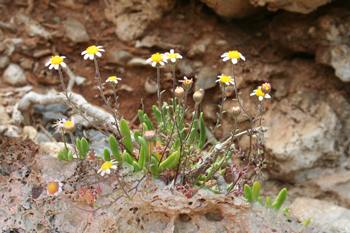Island characteristics overview
 Corsica
Corsica
Mountains comprise two-thirds of the island, forming a single chain, with forests comprising 20% of the land mass (4,020km²). As a result of Corsica's island geography and its diverse topography and landscape, it is home to almost 3,000 plant species. The main reason for the loss of biodiversity in recent decades has been habitat loss, including wild fires. During the hot summer of 2003, almost 20,000 hectares were burnt with around 500 individual fires. There are six nature reserves and 80 Natura2000 sites on the island. However, in light of the wild fire threat, there is an urgent need for ex-situ conservation activities on the island. more...
Crete
Crete's entire length is dominated by four mountain ranges. The proximity of the high mountains to the sea is characterized by narrow deep gorges, accommodating unique habitats. According to the latest update, the flora of Crete comprises 1,742 native species representing 623 genera and 128 families. The flora is the most important centre of endemism in Greece. In lowland areas that are intensively used for agriculture, plant diversity has been reduced due to the spread of exotic invasive species (e.g., Oxalis pes-caprae). In the northern parts of the island, plant diversity is being lost due to intense land development mainly because of tourism. more...
Cyprus
In total, the indigenous flora of Cyprus includes 1,610 species or 1,738 taxa at variety level, while the alien flora includes 238 taxa. The main threats to plant diversity in Cyprus are habitat loss and degradation due to human activities such as tourism development, road construction, fire and drought. more...
Mallorca
Rapid urbanisation of large parts of Mallorca has led to a dramatic loss of space for biodiversity. This has combined with an ever increasing tourism industry, which currently attracts 10 million tourists to the island each year. During the tourist season, water supply is a significant problem, changing the natural water cycle of the island. more...
Sardinia
Sardinia is the second-largest island in the Mediterranean Sea. Its isolation and high geological diversity have created a wide range of habitats with high levels of endemic species, especially on its mountain massifs, where there are conditions of ecological insularity. The Sardinian flora consists of 2,408 taxa (including 2,295 species) and 347 of these are endemics with 45.8% being exclusive endemics. The mountains of Sardinia, even if lower than in Corsica and without any trace of the past glaciations, are high enough to host ecological niches that are absent in the lower bioclimatic belts. Most of the Sardinian endemics are linked to limestone substrata. For some regions of the island, floristic knowledge is still not yet complete. more...
Sicily
3,000 taxa occur on the island, many of which are endemic and with highly relevant phytogeographic value. Sandy and rocky coasts, temporary or persisting salt marshes, deep gorges, mountains and active volcanoes are only a few examples of this unique and extraordinary diversity. Human pressure on natural resources over the past 100 years has driven the disappearance of many habitats and species. Heavy industrialization, land overexploitation and urban sprawl are the main activities causing irreversible damage to biodiversity. The importance of wildlife conservation has been acknowledged by regional legislation but only partial and minor results have been achieved. More targeted ex-situ conservation efforts are urgently needed to preserve biodiversity on the island. more...

